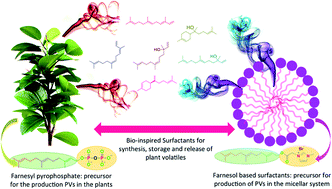Bio-inspired surfactants capable of generating plant volatiles†
Abstract
Plants are able to synthesize, store and release lipophilic organic molecules known as plant volatiles (PVs) utilizing specific biological pathways and different enzymes which play vital roles in the plant's defence and in dealing with biotic and abiotic stress situations. The process of generation, storage and release of PVs by plants acquired during the course of evolution is a very complex phenomenon. Bio-inspired molecular design of farnesol-based surfactants facilitates similar production, storage and release of PVs. The designed molecules adsorb at air–water interface and self-aggregate into micelles in aqueous system. The structural design of the molecules allows them to self-activate in water via intramolecular cation-π interactions. The activated molecules undergo molecular rearrangements generating volatile organic molecules both at interface and inside the micelle core. The molecules adsorbed at the interface initially release the formed volatile molecules creating vacant space at interface, thus thermodynamically directing the micelle to release the manufactured volatile products.


 Please wait while we load your content...
Please wait while we load your content...